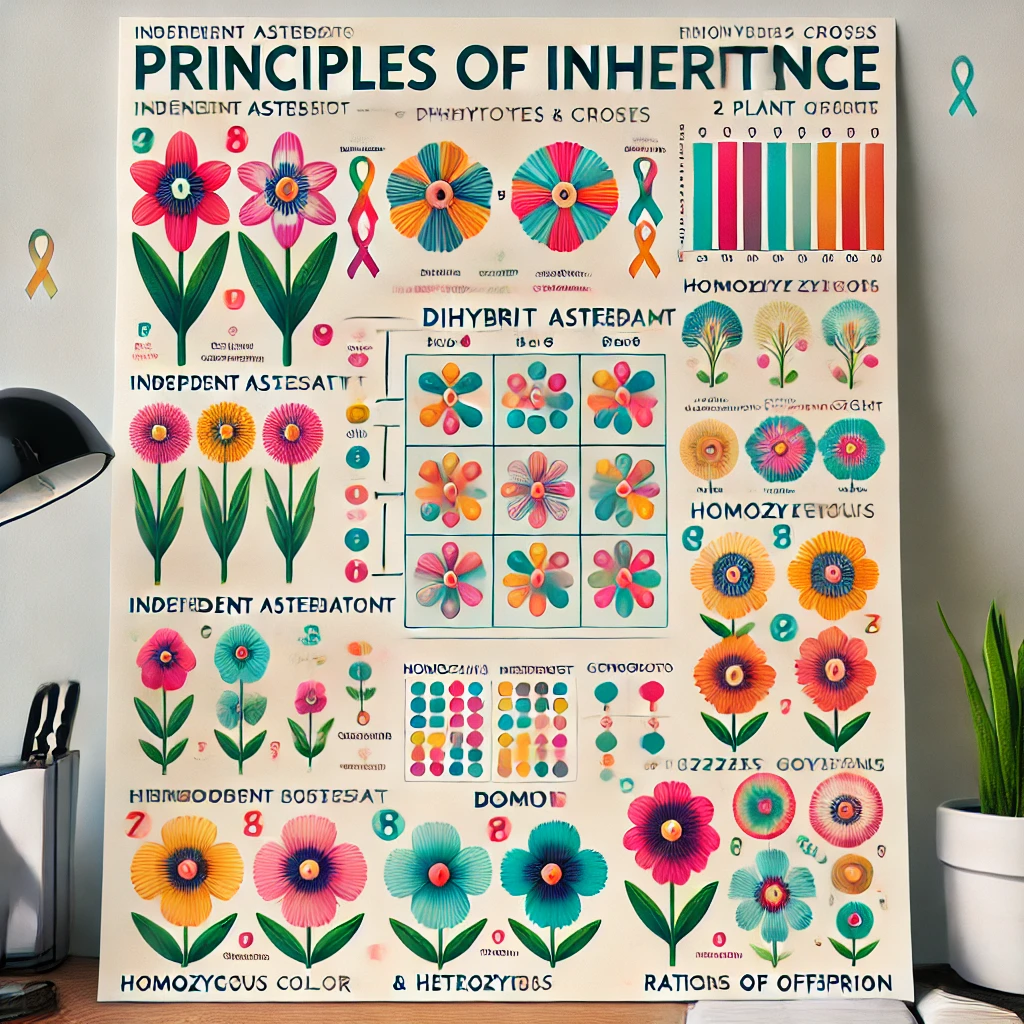
The Inheritance of Two Genes is an extension of Mendel’s studies in genetics and addresses the transmission of two different traits simultaneously. This concept, known as a dihybrid cross, helped Gregor Mendel uncover a key principle in genetics: the Law of Independent Assortment. Through his pea plant experiments, Mendel discovered that genes controlling different traits are inherited independently of each other, provided they are located on different chromosomes. This finding established a fundamental rule in genetics that has implications across biology, medicine, and agriculture.
1. Background: Mendel’s Experiment with Two Traits
While Mendel’s initial experiments involved tracking a single trait, he later conducted experiments on two traits at the same time, or dihybrid crosses. This led to the discovery that traits do not always depend on one another in inheritance patterns. Mendel chose pea plants with combinations of two traits, such as:
- Seed color (yellow or green)
- Seed shape (round or wrinkled)
By observing the inheritance of these two traits simultaneously, Mendel could determine whether or not the traits affected each other during inheritance.
2. The Law of Independent Assortment
The Law of Independent Assortment states that alleles of different genes assort independently of one another during the formation of gametes. This principle applies when the genes in question are located on separate chromosomes or are far apart on the same chromosome, minimizing the likelihood of being inherited together due to linkage.
Definition: According to this law, the inheritance of one trait does not influence the inheritance of another. In other words, the allele a gamete receives for one gene does not affect the allele received for another gene.
Example: In Mendel’s pea plants, the gene for seed color and the gene for seed shape assort independently. This means the allele for yellow seeds (Y) and green seeds (y) is independent of the allele for round seeds (R) and wrinkled seeds (r). This led to offspring that could inherit a variety of combinations of these two traits.
3. Conducting a Dihybrid Cross
In a dihybrid cross, Mendel started by crossing plants that were homozygous for two traits. He used the following symbols for the traits:
- Y for yellow seeds (dominant), y for green seeds (recessive)
- R for round seeds (dominant), r for wrinkled seeds (recessive)
Parental Generation (P Generation)
- Parent 1: Homozygous dominant for both traits (YYRR)
- Parent 2: Homozygous recessive for both traits (yyrr)
F1 Generation
When Mendel crossed these plants, all F1 offspring were heterozygous for both traits (YyRr) and exhibited the dominant traits of yellow and round seeds.
F2 Generation
To observe the independent assortment of alleles, Mendel allowed the F1 generation (YyRr) plants to self-pollinate. This produced four different combinations of alleles in the gametes: YR, Yr, yR, and yr.
Setting Up the Punnett Square
A Punnett square for a dihybrid cross includes 16 boxes because each parent can produce four types of gametes. The possible combinations yield the following results in the F2 generation:
| YR | Yr | yR | yr | |
|---|---|---|---|---|
| YR | YYRR | YYRr | YyRR | YyRr |
| Yr | YYRr | YYrr | YyRr | Yyrr |
| yR | YyRR | YyRr | yyRR | yyRr |
| yr | YyRr | Yyrr | yyRr | yyrr |
Expected Ratios in the F2 Generation
- Phenotypic ratio: 9:3:3:1
- 9 plants with yellow and round seeds (YYRR, YyRR, YYRr, YyRr)
- 3 plants with yellow and wrinkled seeds (YYrr, Yyrr)
- 3 plants with green and round seeds (yyRR, yyRr)
- 1 plant with green and wrinkled seeds (yyrr)
The 9:3:3:1 ratio demonstrates that each trait is inherited independently of the other, confirming the Law of Independent Assortment.
4. Genotypes and Phenotypes in a Dihybrid Cross
In a dihybrid cross:
- Genotypes are the combinations of alleles an organism possesses. For example, YYRR is a genotype with two dominant alleles for both traits.
- Phenotypes are the observable characteristics. In this example, yellow and round seeds are the phenotypic traits that are visible.
In Mendel’s dihybrid cross, the combinations of alleles created diverse phenotypes in the offspring, showing how independent assortment allows for a variety of genetic outcomes in a population.
5. Applications and Implications of the Law of Independent Assortment
The Law of Independent Assortment has far-reaching implications in fields such as genetics, agriculture, and medicine:
- Genetic Diversity: Independent assortment promotes genetic variation within a species by creating different combinations of traits. This diversity is essential for natural selection and adaptation.
- Plant and Animal Breeding: Understanding the independent assortment of traits allows breeders to develop varieties with specific desirable traits, such as increased yield, pest resistance, or specific physical characteristics.
- Human Genetics and Medicine: Independent assortment helps explain how complex traits, especially those influenced by multiple genes, are inherited in humans. Additionally, genetic counselors use this knowledge to assess the likelihood of inherited genetic conditions.
6. Examples in Humans and Other Organisms
In humans and other organisms, dihybrid crosses can be applied to various traits that follow Mendelian inheritance. While complex traits like eye color or height are influenced by multiple genes, simpler traits can sometimes follow Mendel’s rules.
Example of Mendelian Traits in Humans:
- Ear Lobe Attachment: Free vs. attached ear lobes (where free is dominant).
- Tongue Rolling: The ability to roll one’s tongue (where rolling is dominant).
If we imagine a dihybrid cross with two heterozygous parents for these traits, we would observe the same 9:3:3:1 phenotypic ratio, assuming these genes assort independently.
7. Exceptions to Independent Assortment
Mendel’s principles laid the groundwork for modern genetics, but we now know of several exceptions to independent assortment:
- Linked Genes: Genes located close together on the same chromosome tend to be inherited together, a phenomenon known as genetic linkage. These genes do not assort independently.
- Crossing Over: During meiosis, homologous chromosomes can exchange genetic material in a process called recombination or crossing over. This process can shuffle linked genes and alter the expected ratios.
- Polygenic Traits: Many traits, such as skin color and height, are controlled by multiple genes and show continuous variation rather than simple Mendelian inheritance.
8. Importance of Mendel’s Work in Modern Genetics
Mendel’s discovery of independent assortment remains foundational to genetics. His work on dihybrid crosses and the inheritance of multiple traits has informed many areas of study:
- Genetic Mapping: Independent assortment and genetic linkage have helped scientists map the location of genes on chromosomes.
- Genetic Counseling: Understanding inheritance patterns allows genetic counselors to predict the likelihood of genetic conditions in families.
- Conservation Genetics: Independent assortment contributes to genetic diversity, which is essential for conservation efforts aimed at maintaining species diversity.
Index NCERT 12th Class Biology






